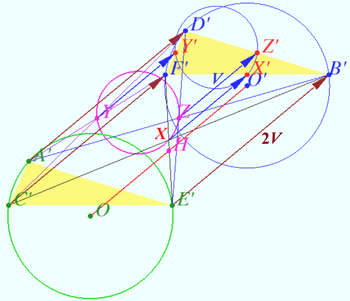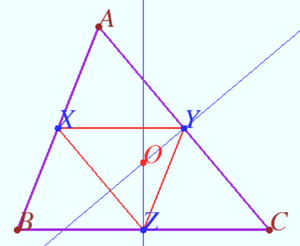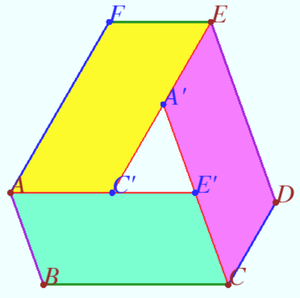Difference between revisions of "2021 USAMO Problems/Problem 6"
(→Solution) |
(→Solution) |
||
| Line 3: | Line 3: | ||
==Solution== | ==Solution== | ||
| − | [[File:2021 USAMO 6b.png| | + | [[File:2021 USAMO 6b.png|350px|right]] |
[[File:2021 USAMO 6c.png|300px|right]] | [[File:2021 USAMO 6c.png|300px|right]] | ||
| − | We construct two equal triangles, prove that triangle <math>XYZ</math> is the medial triangle of both this triangles | + | [[File:2021 USAMO 6a.png|300px|right]] |
| + | We construct two equal triangles, prove that triangle <math>XYZ</math> is the same as medial triangle of both this triangles. We use property of medial triangle and prove that circumcenters of constructed triangles coincide with given circumcenters. | ||
Denote <math>A' = C + E – D, B' = D + F – E, C' = A+ E – F,</math> | Denote <math>A' = C + E – D, B' = D + F – E, C' = A+ E – F,</math> | ||
<math>D' = F+ B – A, E' = A + C – B, F' = B+ D – C.</math> | <math>D' = F+ B – A, E' = A + C – B, F' = B+ D – C.</math> | ||
Then <math>A' – D' = C + E – D – ( F+ B – A) = (A + C + E ) – (B+ D + F).</math> | Then <math>A' – D' = C + E – D – ( F+ B – A) = (A + C + E ) – (B+ D + F).</math> | ||
| + | |||
Denote <math>D' – A' = 2\vec V.</math> | Denote <math>D' – A' = 2\vec V.</math> | ||
Symilarly we get <math>B' – E' = F' – C' = D' – A' \implies</math> | Symilarly we get <math>B' – E' = F' – C' = D' – A' \implies</math> | ||
| − | <math>\triangle | + | <math>\triangle A'C'E' = \triangle D'F'B'.</math> |
| + | |||
| + | The translation vector maps <math>\triangle A'C'E'</math> into <math>\triangle D'F'B'</math> is <math>2\vec {V.}</math> | ||
<math>X = \frac {A+D}{2} = \frac { (A+ E – F) + (D + F – E)}{2} = \frac {C' + B'}{2} = \frac {E' + F'}{2},</math> | <math>X = \frac {A+D}{2} = \frac { (A+ E – F) + (D + F – E)}{2} = \frac {C' + B'}{2} = \frac {E' + F'}{2},</math> | ||
so <math>X</math> is midpoint of <math>AD, B'C',</math> and <math>E'F'.</math> Symilarly <math>Y</math> is the midpoint of <math>BE, A'F',</math> and <math>C'D', Z</math> is the midpoint of <math>CF, A'B',</math> and <math>D'E'.</math> | so <math>X</math> is midpoint of <math>AD, B'C',</math> and <math>E'F'.</math> Symilarly <math>Y</math> is the midpoint of <math>BE, A'F',</math> and <math>C'D', Z</math> is the midpoint of <math>CF, A'B',</math> and <math>D'E'.</math> | ||
<math>Z + V = \frac {A' + B'}{2}+ \frac {D' – A'}{2} = \frac {B' + D'}{2} = Z'</math> is the midpoint of <math>B'D'.</math> | <math>Z + V = \frac {A' + B'}{2}+ \frac {D' – A'}{2} = \frac {B' + D'}{2} = Z'</math> is the midpoint of <math>B'D'.</math> | ||
| − | Symilarly <math>X' = X + V</math> is the midpoint of <math>B'F',Y'= Y + V</math> is the midpoint of <math>D'F' | + | |
| − | It is known (see diagram) that circumcenter of triangle | + | Symilarly <math>X' = X + V</math> is the midpoint of <math>B'F',Y'= Y + V</math> is the midpoint of <math>D'F'.</math> |
| + | |||
| + | Therefore <math>\triangle X'Y'Z'</math> is the medial triangle of <math>\triangle B'D'F'.</math> | ||
| + | |||
| + | <math>\triangle XYZ</math> is <math>\triangle X'Y'Z'</math> translated on <math>– \vec {V}.</math> | ||
| + | |||
| + | It is known (see diagram) that circumcenter of triangle coincide with orthocenter of the medial triangle. Therefore orthocenter <math>H</math> of <math>\triangle XYZ</math> is circumcenter of <math>\triangle B'D'F'</math> translated on <math>– \vec {V}.</math> It is the midpoint of segment <math>OO'</math> connected circumcenters of <math>\triangle B'D'F'</math> and <math>\triangle A'C'E'.</math> | ||
According to the definition of points <math>A', C', E', ABCE', CDEA',</math> and <math>AFEC'</math> are parallelograms <math>\implies</math> | According to the definition of points <math>A', C', E', ABCE', CDEA',</math> and <math>AFEC'</math> are parallelograms <math>\implies</math> | ||
<cmath>AC' = FE, AE' = BC, CE' = AB, CA' = DE, EA' = CD, EC' = AF \implies</cmath> | <cmath>AC' = FE, AE' = BC, CE' = AB, CA' = DE, EA' = CD, EC' = AF \implies</cmath> | ||
<cmath>AC' \cdot AE' = CE' \cdot CA' = EA' \cdot EC' \implies</cmath> Power of points A,C, and E with respect circumcircle \triangle A'C'E' is equal, hence distances between these points and circumcenter of \triangle A'C'E' are the same \implies circumcenters of constructed triangles coincide with given circumcenters. | <cmath>AC' \cdot AE' = CE' \cdot CA' = EA' \cdot EC' \implies</cmath> Power of points A,C, and E with respect circumcircle \triangle A'C'E' is equal, hence distances between these points and circumcenter of \triangle A'C'E' are the same \implies circumcenters of constructed triangles coincide with given circumcenters. | ||
Revision as of 08:57, 15 September 2022
Problem 6
Let ![]() be a convex hexagon satisfying
be a convex hexagon satisfying ![]() ,
, ![]() ,
, ![]() , and
, and![]() Let
Let ![]() ,
, ![]() , and
, and ![]() be the midpoints of
be the midpoints of ![]() ,
, ![]() , and
, and ![]() . Prove that the circumcenter of
. Prove that the circumcenter of ![]() , the circumcenter of
, the circumcenter of ![]() , and the orthocenter of
, and the orthocenter of ![]() are collinear.
are collinear.
Solution
We construct two equal triangles, prove that triangle ![]() is the same as medial triangle of both this triangles. We use property of medial triangle and prove that circumcenters of constructed triangles coincide with given circumcenters.
is the same as medial triangle of both this triangles. We use property of medial triangle and prove that circumcenters of constructed triangles coincide with given circumcenters.
Denote ![]()
![]() Then
Then ![]()
Denote ![]()
Symilarly we get ![]()
![]()
The translation vector maps ![]() into
into ![]() is
is ![]()
![]()
so ![]() is midpoint of
is midpoint of ![]() and
and ![]() Symilarly
Symilarly ![]() is the midpoint of
is the midpoint of ![]() and
and ![]() is the midpoint of
is the midpoint of ![]() and
and ![]()
![]() is the midpoint of
is the midpoint of ![]()
Symilarly ![]() is the midpoint of
is the midpoint of ![]() is the midpoint of
is the midpoint of ![]()
Therefore ![]() is the medial triangle of
is the medial triangle of ![]()
![]() is
is ![]() translated on
translated on ![]()
It is known (see diagram) that circumcenter of triangle coincide with orthocenter of the medial triangle. Therefore orthocenter ![]() of
of ![]() is circumcenter of
is circumcenter of ![]() translated on
translated on ![]() It is the midpoint of segment
It is the midpoint of segment ![]() connected circumcenters of
connected circumcenters of ![]() and
and ![]()
According to the definition of points ![]() and
and ![]() are parallelograms
are parallelograms ![]()
![]()
![]() Power of points A,C, and E with respect circumcircle \triangle A'C'E' is equal, hence distances between these points and circumcenter of \triangle A'C'E' are the same \implies circumcenters of constructed triangles coincide with given circumcenters.
Power of points A,C, and E with respect circumcircle \triangle A'C'E' is equal, hence distances between these points and circumcenter of \triangle A'C'E' are the same \implies circumcenters of constructed triangles coincide with given circumcenters.












